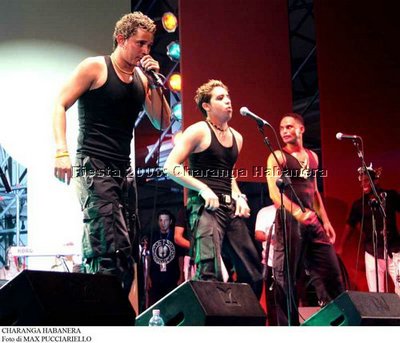12.20.4 Charanga Habanera

La Charanga Habanera, a Cuban popular dance music orchestra, was founded in 1988. It was made up of a group of talented musicians who graduated from the country’s art schools. The group was created to fulfill a work commitment at the Sporting Club of Monte Carlo, constituting a project that performed Cuban popular music from the 1940s and 1950s. They played various genres of traditional Cuban music such as Cha-Cha-Chá, Mambo, Bolero, and Guaracha. Due to its great success, the contract was extended to five years.
During those years, La Charanga Habanera recorded its first album with DOM. It had the opportunity to share the stage with internationally renowned musicians such as Donna Summer, Barry White, Ray Charles, Stevie Wonder, Frank Sinatra, Jerry Lewis, Whitney Houston, and Kool and the Gang.
During this period, the Charanga also worked hard not only to expand its repertoire to encompass diverse musical genres, but also to perfect its staging.
The orchestra has a new instrumental format as a result of a proposal made by its director David Calzado, with the aim of obtaining a modern sound quality. It consists of: pailas, congas, flute, keyboard, two violins, piano, alto saxophone, two trumpets and two singers.
In the 1990s, La Charanga Habanera, made up of young Cuban musicians, included daring choreographies in its performances featuring all its members. Calzado incorporated new musical instruments into the Charanga’s previous format, establishing the instrumental format it currently displays. This led to changes in timbre.
New recordings were made with Magic Music-Universal, in addition to extensive international tours. In 1998, they became and won the award for most popular orchestra of the year. They reached the top spots on Cuban radio and television, with four hits during the years 1998 and 1999, results they repeated in 1999, 2000, and 2001.
In 2003, their album “Live In The USA” was nominated for a Latin Grammy Award. In 2005, they were nominated in three categories: Best Video, Best Album, and Best Group at Orgullosamente Latino. Lucas and his band have also received several awards at Cubadisco.
La Charanga Habanera achieved its greatest commercial success with the album “La Carátula” in 2009. It featured the renowned Cuban reggaeton artist El Chacal. Highlights include songs such as “La Carátula,” “Hay mujeres,” and “Gozando en La Habana.” That same year, they won an award at the Lucas Awards, the country’s annual event, for their video for the song “Gozando en La Habana.”
Through their tours, the group has taken their music all over the world, to countries including Peru, Mexico, Argentina, the United States, Japan, as well as Europe and North Africa. They have participated in major international events such as the Campanille Festival in Italy and the Pacific Fair in Peru.
La Charanga Habanera plays music filled with a vigorous, distinctive rhythm, as well as being extremely catchy. It has stood out for its versatility, its attire, and the sensual content of its songs. The quality of its performance, its flavor, and its artistic dedication have always been present in La Charanga Habanera since its founding, earning it countless accolades from both audiences and critics. Their performances attract large crowds, comprised of different generations, in terms of age.
The Charanga Habanera is one of the most important Cuban popular music orchestras in existence today, contributing to raising the quality of Cuban music and spreading it around the world.
Discography: Charanga Habanera, Volume I (1988), From Havana to Monte Carlo (1989), My Fever Is Up (1994), Hey You, Crazy (1995), So That Havana Finds Out (1996), Tremendo Delirio (1997), I’m Cuban, I’m Popular (2003), Marina Wants to Dance! (2003), Charanga Light (2004), The Havana Cyclone (2005), The King of the Charangueros (2008), Don’t Look at the Cover (2009).








